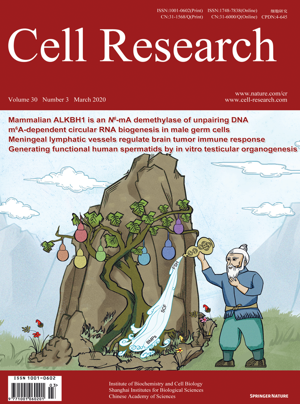
Volume 30, No 3, Mar 2020
ISSN: 1001-0602
EISSN: 1748-7838 2018
impact factor 17.848*
(Clarivate Analytics, 2019)
Volume 30 Issue 3, March 2020: 211-228
ORIGINAL ARTICLES
m6A-dependent biogenesis of circular RNAs in male germ cells
Chong Tang 1,2 , Yeming Xie1, Tian Yu1, Na Liu2, Zhuqing Wang 1, Rebekah J. Woolsey3, Yunge Tang 4,5, Xinzong Zhang 4,5,Weibing Qin 4,5, Ying Zhang 4,5, Ge Song 4,5, Weiwei Zheng 4,5, Juan Wang2, Weitian Chen2, Xiongyi Wei2, Zhe Xie 2,6, Rachel Klukovich1,Huili Zheng1, David R. Quilici3 and Wei Yan 1,7,8
1 Department of Physiology and Cell Biology, University of Nevada, Reno School of Medicine, Reno, NV 89557, USA; 2BGI Co. Ltd., Shenzhen 518083, China; 3Nevada Proteomics Center, University of Nevada, Reno, Reno, NV 89557, USA; 4Key Laboratory of Male Reproduction and Genetics, National Health and Family Planning Commission, No. 17 Meidong Road, Yuexiu District, Guangzhou 510600, China; 5Family Planning Research Institute of Guangdong Province, No. 17 Meidong Road, Yuexiu District, Guangzhou 510600, China; 6Department of Cell Biology and Physiology, University of Copenhagen 13, 2100 Copenhagen, Denmark; 7Department of Obstetrics and Gynecology, University of Nevada, Reno,School of Medicine, Reno, NV 89557, USA and 8Department of Biology, University of Nevada, Reno, Reno, NV 89557, USA
Correspondence: Chong Tang (leochong718@gmail.com) or Wei Yan (wyan@med.unr.edu)These authors contributed equally: Chong Tang, Yeming Xie, Tian Yu, Na Liu
The majority of circular RNAs (circRNAs) spliced from coding genes contain open reading frames (ORFs) and thus, have protein coding potential. However, it remains unknown what regulates the biogenesis of these ORF-containing circRNAs, whether they are actually translated into proteins and what functions they play in specific physiological contexts. Here, we report that a large number of circRNAs are synthesized with increasing abundance when late pachytene spermatocytes develop into round and then elongating spermatids during murine spermatogenesis. For a subset of circRNAs, the back splicing appears to occur mostly at m6A-enriched sites, which are usually located around the start and stop codons in linear mRNAs. Consequently, approximately a half of these male germ cell circRNAs contain large ORFs with m6A-modified start codons in their junctions, features that have been recently shown to be associated with protein-coding potential. Hundreds of peptides encoded by the junction sequences of these circRNAs were detected using liquid chromatography coupled with mass spectrometry, suggesting that these circRNAs can indeed be translated into proteins in both developing (spermatocytes and spermatids) and mature (spermatozoa) male germ cells. The present study discovered not only a novel role of m6A in the biogenesis of coding circRNAs, but also a potential mechanism to ensure stable and long-lasting protein production in the absence of linear mRNAs, i.e., through production of circRNAs containing large ORFs and m6A-modified start codons in junction sequences.
https://doi.org/10.1038/s41422-020-0279-8
FULL TEXT | PDF
Browse 1016


